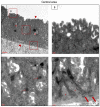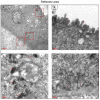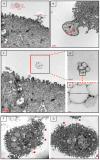Mapping of the Human Amniotic Membrane: In Situ Detection of Microvesicles Secreted by Amniotic Epithelial Cells
- PMID: 37077027
- PMCID: PMC10126782
- DOI: 10.1177/09636897231166209
Mapping of the Human Amniotic Membrane: In Situ Detection of Microvesicles Secreted by Amniotic Epithelial Cells
Abstract
The potential clinical applications of human amniotic membrane (hAM) and human amniotic epithelial cells (hAECs) in the field of regenerative medicine have been known in literature since long. However, it has yet to be elucidated whether hAM contains different anatomical regions with different plasticity and differentiation potential. Recently, for the first time, we highlighted many differences in terms of morphology, marker expression, and differentiation capabilities among four distinct anatomical regions of hAM, demonstrating peculiar functional features in hAEC populations. The aim of this study was to investigate in situ the ultrastructure of the four different regions of hAM by means of transmission electron microscopy (TEM) to deeply understand their peculiar characteristics and to investigate the presence and localization of secretory products because to our knowledge, there are no similar studies in the literature. The results of this study confirm our previous observations of hAM heterogeneity and highlight for the first time that hAM can produce extracellular vesicles (EVs) in a heterogeneous manner. These findings should be considered to increase efficiency of hAM applications within a therapeutic context.
Keywords: amniotic epithelial cells; amniotic membrane; electron microscopy; microvesicles; stem cells.
Conflict of interest statement
The author(s) declared no potential conflicts of interest with respect to the research, authorship, and/or publication of this article.
Figures







Similar articles
-
Coagulation activation and hepatic engraftment of human amnion-derived cells after intraportal transplantation in rats.Regen Med. 2025 Jun;20(6):233-242. doi: 10.1080/17460751.2025.2526915. Epub 2025 Jun 30. Regen Med. 2025. PMID: 40586279
-
The Black Book of Psychotropic Dosing and Monitoring.Psychopharmacol Bull. 2024 Jul 8;54(3):8-59. Psychopharmacol Bull. 2024. PMID: 38993656 Free PMC article. Review.
-
Behavioral interventions to reduce risk for sexual transmission of HIV among men who have sex with men.Cochrane Database Syst Rev. 2008 Jul 16;(3):CD001230. doi: 10.1002/14651858.CD001230.pub2. Cochrane Database Syst Rev. 2008. PMID: 18646068
-
Conjunctival autograft for pterygium.Cochrane Database Syst Rev. 2016 Feb 11;2(2):CD011349. doi: 10.1002/14651858.CD011349.pub2. Cochrane Database Syst Rev. 2016. PMID: 26867004 Free PMC article.
-
[Volume and health outcomes: evidence from systematic reviews and from evaluation of Italian hospital data].Epidemiol Prev. 2013 Mar-Jun;37(2-3 Suppl 2):1-100. Epidemiol Prev. 2013. PMID: 23851286 Italian.
Cited by
-
Novel Ultrastructural Insights into the Clear-Cell Carcinoma of the Pancreas: A Case Report.Int J Mol Sci. 2024 Apr 13;25(8):4313. doi: 10.3390/ijms25084313. Int J Mol Sci. 2024. PMID: 38673897 Free PMC article.
-
Recommendations from the COST action CA17116 (SPRINT) for the standardization of perinatal derivative preparation and in vitro testing.Front Bioeng Biotechnol. 2023 Nov 14;11:1258753. doi: 10.3389/fbioe.2023.1258753. eCollection 2023. Front Bioeng Biotechnol. 2023. PMID: 38033821 Free PMC article.
-
Prospects for the Application of Transplantation With Human Amniotic Membrane Epithelial Stem Cells in Systemic Lupus Erythematosus.Cell Transplant. 2024 Jan-Dec;33:9636897241236586. doi: 10.1177/09636897241236586. Cell Transplant. 2024. PMID: 38469823 Free PMC article. Review.
-
Unveiling the human fetal-maternal interface during the first trimester: biophysical knowledge and gaps.Front Cell Dev Biol. 2024 Jul 31;12:1411582. doi: 10.3389/fcell.2024.1411582. eCollection 2024. Front Cell Dev Biol. 2024. PMID: 39144254 Free PMC article. Review.
-
A dynamic flow fetal membrane organ-on-a-chip system for modeling the effects of amniotic fluid motion.Biomed Microdevices. 2024 Jul 4;26(3):32. doi: 10.1007/s10544-024-00714-1. Biomed Microdevices. 2024. PMID: 38963644 Free PMC article.
References
-
- Parolini O, Alviano F, Bagnara GP, Bilic G, Bühring HJ, Evangelista M, Hennerbichler S, Liu B, Magatti M, Mao N, Miki T, et al.. Concise review: isolation and characterization of cells from human term placenta: outcome of the first international workshop on placenta derived stem cells. Stem Cells. 2008;26(2):300–11. - PubMed
-
- Silini AR, Di Pietro R, Lang-Olip I, Alviano F, Banerjee A, Basile M, Borutinskaite V, Eissner G, Gellhaus A, Giebel B, Huang YC, et al.. Perinatal derivatives: where do we stand? A roadmap of the human placenta and consensus for tissue and cell nomenclature. Front Bioeng Biotechnol. 2020;8:610544. - PMC - PubMed
-
- Dua HS, Gomes JA, King AJ, Maharajan V. The amniotic membrane in ophthalmology. Surv Ophthalmol. 2004;49:51–77. - PubMed
Publication types
MeSH terms
LinkOut - more resources
Full Text Sources

